Apr 20, 2024
Apr 20, 2024
Director: Sergei Parajanov/ Armenia/Armenian/78mts
The Color of Pomegranates (Sayat Nova) by the late Soviet director, Sergei Paradjanov, makes an earnest attempt to fuse poetry and film by seriously exploring the poetic potential of the cinema. This deliriously beautiful film is made up of autonomous, resonant images that – like lines of poetry – stay in the mind long after the film has run its course. The Color of Pomegranates seems to resist or even defy explanation.
Sergei Paradjanov (1924-1990) has been acclaimed as the greatest Russian filmmaker to appear since the golden age of Eisenstein and Dovzhenko. His baroque masterpiece, The Color Of Pomegranates, was banned in Russia for its religious sentiment and nonconformity to “Socialist realism”; its director, a tirelessly outspoken campaigner for human rights, was convicted on a number of trumped up charges and sentenced to five years of hard labor in the gulag. A wave of protest from the international film community led to his release in 1978.
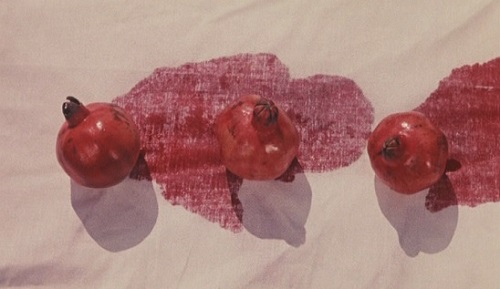
Pomegranates bleed on clothes
Between his abandonment of socialist realism in 1964 and his death from lung cancer in 1990, Sergei Paradjanov made four of the weirdest and most beautiful movies ever seen. An ethnic Armenian, Paradjanov was born in Soviet Georgia in 1924. His mother was “very artistic”: she “used to adorn herself with Christmas tree decorations and curtains and join her friends on the roof to enact legends”. In 1947, Paradjanov spent a brief stint in a Georgian prison for committing “homosexual acts” (which were illegal under Soviet law) – with, of all people, a KGB officer. He later disavowed the seven films he shot in the 1950s and early 1960s. In 1962, he saw Tarkovsky’s Ivan’s Childhood and completely changed his artistic method, which had previously been quite normal.
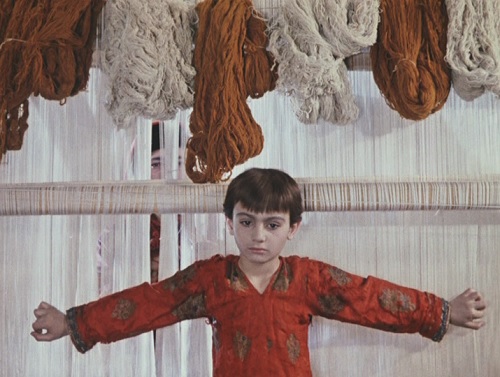
The poet as a boy
The film is essentially a biography of the Armenian troubadour-poet Aruthin Sayadian (1712-1795), who was known as Sayat-Nova. Born in the capital of Georgia, Tiblisi, Sayat-Nova began his career as a wool-dyer in his family’s trade. Educated in literature by the Armenian Church, he composed hundreds of songs and poems and would rise to become a poet in the royal courts of Tiblisi and Telavi in Eastern Georgia. In his later life, after the death of his wife, Marmar, Sayat-Nova became a monk at the Haghpat monastery. He lived there until his death at the hands of the Persian army, when Agha Mohammed Khan sacked Armenia. His songs continue to be sung in the Caucasus today. While The Color of Pomegranates avoids the typical formula for a biopic, all of these events are clearly depicted in a linear order.
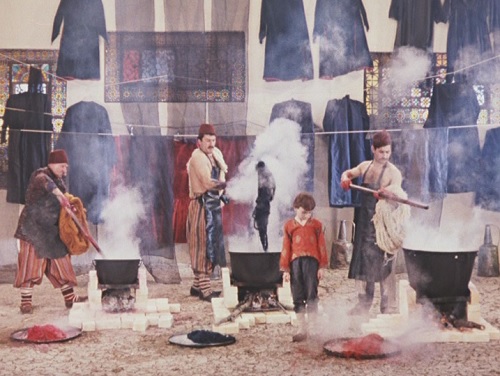
A cloth dying scene
Paradjanov has described the film as a series of Persian miniatures. The camera remains fixed in place, as in early cinema, while the director’s visual theme resembles a tableau-vivant, a mixture of theatre and painting. Rather than zooming or changing focal lengths, people and animals move closer and farther away from the camera, objects relating to each other in a two-dimensional manner. Each significant aspect of the poet’s life is thus represented in these highly stylized, synthetic scenes: Sayat-Nova’s work as a dyer; music lessons; and the burial of a Catholics, an important Armenian Church father, for whom the poet wrote an elegy. Domesticated animals find their way into virtually every frame, including an extraordinary moment in which the protagonist finds himself in a church filled to the corners with sheep during this burial scene. Mirroring Sayat-Nova’s lyric style, Paradjanov heightens the sensory details of the scenes: the sound of hot, wet, newly dyed wool hitting metal salvers, the squishy sound of grapes bursting underneath toes.
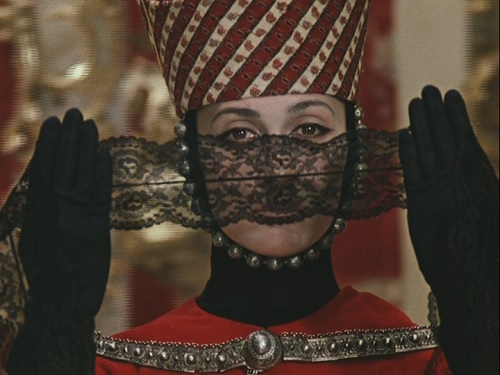
The black lace covering Marmar’s face in marriage scene
Significant moments are repeated and replayed as in memory and verse, sometimes with slight variations to account for shifts in feeling and perspective. For example, the lace covering Marmar’s mouth in the marriage scene changes from the white of innocence to the red of passion and the blackness of death and loss. Red in the form of dye, pomegranate juice and blood appears throughout the film, bearing the weight of metaphoric meanings, from love to the martyrdom of the Armenian people.
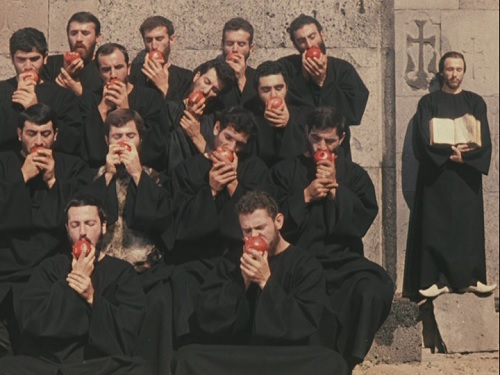
A group munching pomegranate
Aesthetically the most extreme film ever made in the USSR, Color of Pomegranates his hallucinatory epic account of the life of the 18th century Armenian national poet Sayat Nova, conveys the glory of what a cinema of high art can be like. Conceived as an extraordinarily complex series of painterly tableaux that recall Byzantine mosaics, the film is dreamlike icon come-to-life of astonishing beauty and rigor. It evokes the poet’s childhood and youth, his days as a troubadour at the court of King Heraclius II of Georgia, his retreat to a monastery, his old age and death. It aims to tell his story poetically rather than literally and deals with the poet’s soul and destiny. Michelangelo Antonioni called it a film “of a stunningly perfect beauty”.
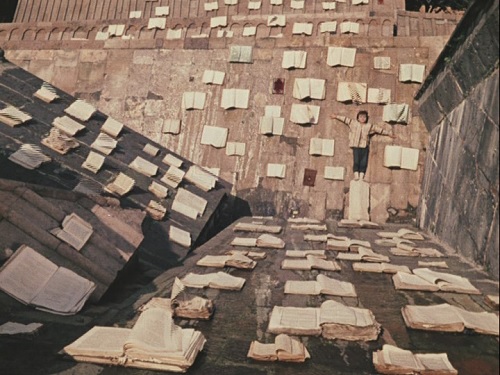
From Poet’s Childhood: Books are soul and life
The images correspond to the poet’s inner world and moments of his life rather than any conventional biographic details. Pomegranates bleed their juice into a cloth and form a stain in the shape of the boundaries of the ancient Kingdom of Armenia; dyers lift hanks of wool out of vats in the colors of the national flag, the poet changes sex at least once in the course of his career, angels descend: the result is a stream of religious, poetic and local iconography which has an arcane and astonishing beauty. Particularly astounding are the courtship “scenes” in which the poet and his lover are both played by the lithe, unearthly actress Sofiko Chiaureli: a trick that renders visual and literal the union of the poet-lover and the beloved-God in eastern mystical poetry.
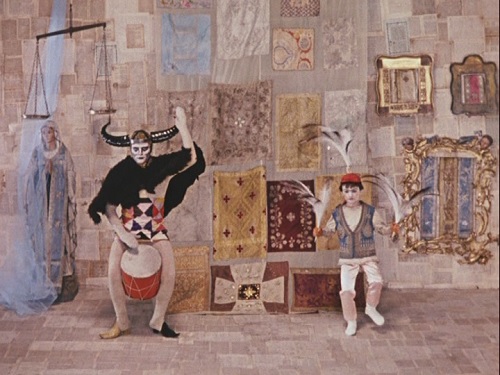
A folk dance
Pomegranates is thus a hallucinatory mash-up of these two types of material: a life story told in brilliantly colored and animated Persian miniatures. The actors, dressed in outlandishly detailed handmade costumes, move as if by some strange clockwork, performing repetitive stylized gestures, tossing a golden ball in the air or gesturing enigmatically with some symbolic-looking object: a seashell, a candle, a rifle. Paradjanov himself compared Pomegranates to a “Persian jewelry case”: “On the outside, its beauty fills the eyes; you see the fine miniatures. Then you open it, and inside you see still more Persian accessories.” An accurate description: every last article and action in the film seems precisely placed, exquisitely detailed and designed to serve a particular purpose in some unknown ritual.
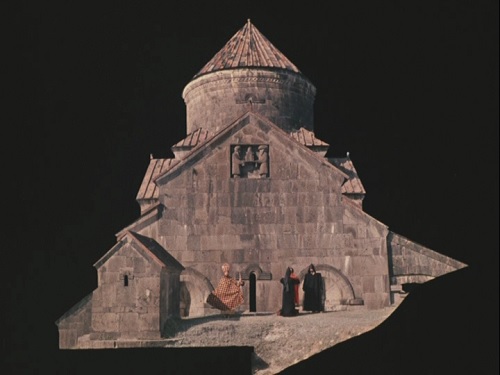
From poet’s Monastery period
The only “narrative” is provided by the successive replacement of a small boy with a youth, a monk and an old man: it’s like an illustration of the riddle of the sphinx. There are a succession of painterly images (with motion in many of them, particularly horses passing through the frame, and sheep filling up a church sanctuary) rather than a plot or character development, and lines of mostly anguished/ecstatic poetry. The lines of poetry are fairly abstract ones about love, longings, and spiritually, which is to say even less narrative than the movie is. “How am I to protect my wax-built castles of love from the devouring heat of your fires?” is somewhat more concrete than most. (That is, one could show a wax castle, but not one being melted by the firest of love.) “Burning” is a recurrent trope in what Paradjanov included of the poetry.
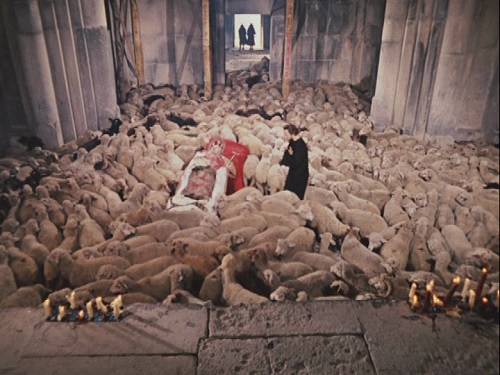
Poet in Monastery: Sheep flooding a church during burial scene
Pomegranates is a hallucinatory mash-up of these two types of material: a life story told in brilliantly colored and animated Persian miniatures. The actors, dressed in outlandishly detailed handmade costumes, move as if by some strange clockwork, performing repetitive stylized gestures, tossing a golden ball in the air or gesturing enigmatically with some symbolic-looking object: a seashell, a candle, a rifle. Paradjanov himself compared Pomegranates to a “Persian jewellery case”: “On the outside, its beauty fills the eyes; you see the fine miniatures. Then you open it, and inside you see still more Persian accessories.” An accurate description: every last article and action in the film seems precisely placed, exquisitely detailed and designed to serve a particular purpose in some unknown ritual.
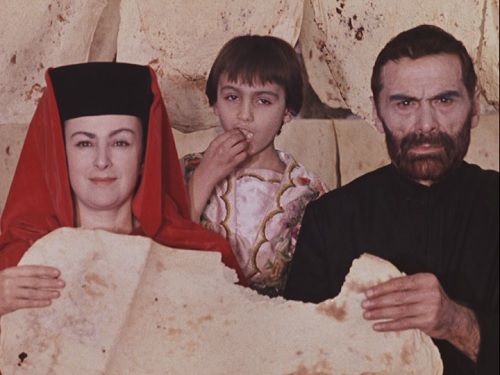
From the poet’s dream
The outrageousness of Paradjanov’s imagination is best encapsulated by the final scene of The Color of Pomegranates, in which death comes to the poet in the form of a shower of live chickens. Dressed in white, the troubadour lies on the floor, surrounded by candles; the chickens, who seem to be upset about something, fall on to him from a great height, dispensing a flurry of white feathers and extinguishing the candles. It’s not the way you would expect a national poet or anyone really, to depart this world – but Paradjanov makes it look inevitable.
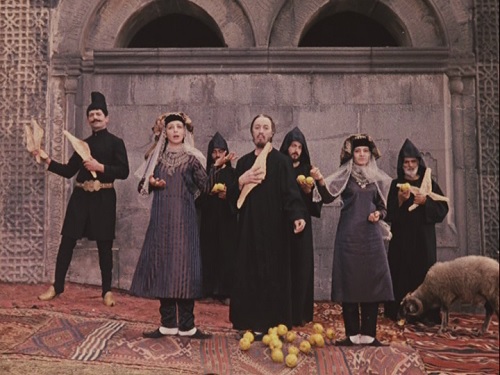
The poet in Old age
The Color of Pomegranates is the last film Paradjanov he made after 15 years. In 1973, after indictments for art trafficking, currency fraud, “incitements to suicide” and surrealist tendencies, the director was sentenced to five years in a maximum-security gulag, where his duties included sewing sacks. An indomitable spirit, he became an expert at making dolls from leftover sackcloth. He made a doll of Tutankhamen and another of his friend Lilya Brik. Through the offices of Brik, Tarkovsky and other powerful friends, Paradjanov was released one year early, in 1977. He wasn’t allowed to work, and lived in utter destitution in Tbilisi. At one point, Tarkovsky gave him a ring to pawn, but Paradjanov decided to keep it as a souvenir of their friendship.
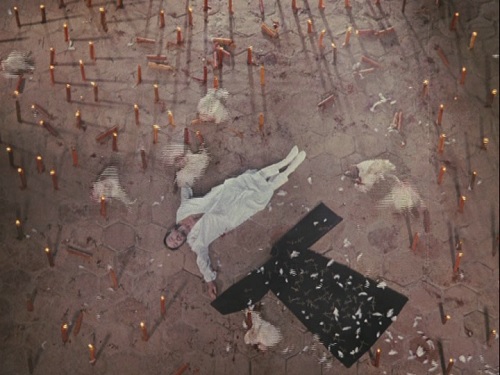
The poet’s death with decapitated chicken flying around candles
Pomegranates are an ancient symbol of beauty, power and strength. This film, too, as an aesthetic challenge to the Soviets and as a wild imagistic narrative, is a symbol of the power of art in all its forms - film, art, poetry and more. It is this iconoclastic director’s masterpiece and must be enjoyed with all of one’s senses.
A series of "Hundred Favorite Films Forever"
04-May-2013
More by : P. G. R. Nair